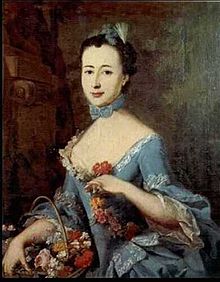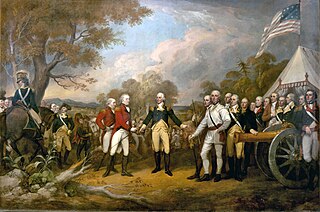
The Battles of Saratoga marked the climax of the Saratoga campaign, giving a decisive victory to the Americans over the British in the American Revolutionary War. British General John Burgoyne led an invasion army of 7,200–8,000 men southward from Canada in the Champlain Valley, hoping to meet a similar British force marching northward from New York City and another British force marching eastward from Lake Ontario; the goal was to take Albany, New York. The southern and western forces never arrived, and Burgoyne was surrounded by American forces in upstate New York 15 miles (24 km) short of his goal. He fought two battles which took place 18 days apart on the same ground 9 miles (14 km) south of Saratoga, New York. He gained a victory in the first battle despite being outnumbered, but lost the second battle after the Americans returned with an even larger force.
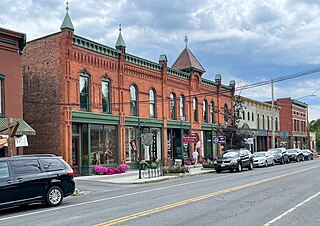
Schuylerville is a village in Saratoga County, New York, United States. The village is located in the northeastern part of the Town of Saratoga, east of Saratoga Springs. The Village of Victory is adjacent to Schuylerville to the southwest and the Hudson River forms the village's eastern border. The population was 1,370 at the 2020 census. The village was incorporated in 1831 and is named after the Schuyler family, a prominent family of Dutch descent in colonial America.
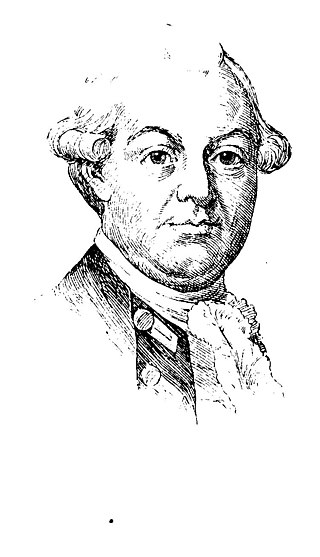
Simon Fraser was a British general during the American War of Independence. He was killed in the Battle of Bemis Heights during the Saratoga Campaign. The shot that killed Fraser is often attributed to Timothy Murphy, of Daniel Morgan's Rifle Corps, which was assigned to the Left and under the command of Benedict Arnold, who was leading Morgan's men as well as Dearborn, Cilley, Poor, and the rest of the American left wing, which was attempting to push back the reconnaissance in force led by Simon Fraser on the Barber Wheatfield.

Freiherr Friedrich Adolf Riedesel Freiherr zu Eisenbach was a German officer who served in the Seven Years' War and American War of Independence. He was the commander of the Braunschweiger Jäger, a regiment of soldiers from the Principality of Brunswick-Wolfenbüttel that was among the German units hired by the British during the American War of Independence. He then commanded all German soldiers in the Saratoga Campaign.

The Convention Army (1777–1783) was an army of British and allied troops captured after the Battles of Saratoga in the American Revolutionary War.

Charles William Ferdinand was the prince of Brunswick-Wolfenbüttel and duke of Brunswick-Lüneburg and a military leader. His titles are usually shortened to Duke of Brunswick in English-language sources.
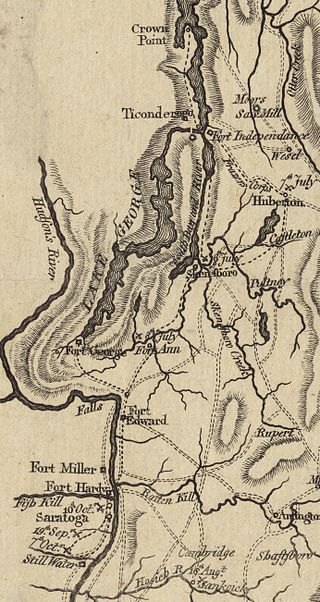
The Battle of Hubbardton was an engagement in the Saratoga campaign of the American Revolutionary War fought in the village of Hubbardton, Vermont. Vermont was then a disputed territory sometimes called the New Hampshire Grants, claimed by New York, New Hampshire, and the newly organized, not yet recognized, but de facto independent government of Vermont. On the morning of July 7, 1777, British forces, under General Simon Fraser, caught up with the American rear guard of the forces retreating after the withdrawal from Fort Ticonderoga. It was the only battle in Vermont during the revolution.
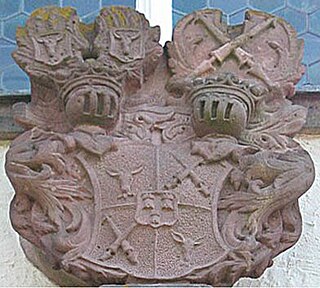
The Riedesel family is a German noble family that began to appear in legal documents in the early 13th century. They were of the knightly class, though not all had the official status of Ritter or knight. Its exact geographical and temporal origins are uncertain. However, all of the early references are from the area of Hesse, and many served as vassals of the Margrave of Hesse in Marburg. In later centuries, the men served a wide variety of higher nobility as men-at-arms, administrators, and counselors.

Saratoga National Historical Park is a United States National Historical Park located in the Town of Stillwater in eastern New York, 30 miles north of Albany. The park preserves the site of the Battles of Saratoga.

Friedrich Wilhelm von Reden was a German pioneer in mining and metallurgy. He was born in Hamelin in the Electorate of Hanover and died in Schloss Buchwald in Prussian Silesia.
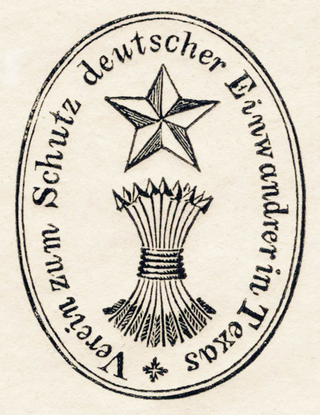
August Ludwig Karl Georg Friedrich Freiherr von Bibra was director of the business affairs of Hermann, prince of Wied. He became general manager of the Adelsverein, or Verein zum Schutze Deutscher Einwanderer in Texas.
The northern theater of the American Revolutionary War also known as the Northern Department of the Continental Army was a theater of operations during the American Revolutionary War.

People of German ancestry fought on both sides in the American Revolution. Many of the small German states in Europe supported the British. King George III of Britain was simultaneously the ruler of the German state of Hanover. Around 30,000 Germans fought for the British during the war, around 25% of British land forces. In particular, 12,000 Hessian soldiers served as mercenaries on the side of British. However some Germans who were supporters of Congress as individuals crossed the Atlantic to help the Patriots.
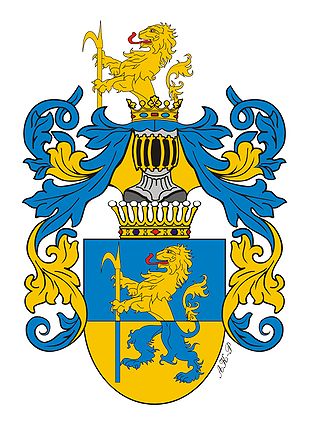
The Hauke-Bosak is a German-Polish noble family. Originally a German middle class family, they settled in Poland at the end of the 18th century and achieved great importance and titles of nobility in the Kingdom of Poland, the Russian Empire, the Austrian Empire, and the Grand Duchy of Hesse.

Old Fort House is a historic house at 29 Lower Broadway in Fort Edward, Washington County, New York. The house is owned by the Fort Edward Historical Association and operated as a local history museum. The Old Fort House was listed on the National Register of Historic Places in 1983.
The Marshall House is a house in Schuylerville, New York listed on the National Register of Historic Places for both its place in American history and its architectural significance.
Captain Christian Theodor von Pincier, later known as Theodore Pincier, Esquire, or as Theodore de Pencier, was a Brunswick Army Officer who served on the British side during the American Revolution. Following the peace treaty, he became a settler and well-known surveyor in colonial British Quebec. He was the illegitimate son of Charles I, Duke of Brunswick-Wolfenbüttel, who was adopted into the Pincier von Königstein family, known as von Pincier in German and Swedish, then to dePencier & Depencier. Theodor was the adopted child of Braunschweig Army General von Pincier.

Friederike von Reden (1774–1854), was a German noblewoman, philanthropist and salon-holder. She is known as the Mutter des Hirschberger Tales.

Brunswick troops in the American Revolutionary War served as auxiliaries to the British Army during the American Revolutionary War, in accordance with the treaty of 1776 between Great Britain and the Principality of Brunswick-Wolfenbüttel. Four regiments of foot, one regiment of dragoons, one grenadier battalion, and one light battalion with a Jäger company were dispatched to British America. Most of the Brunswick troops fought at the Battles of Saratoga, where they were forced to surrender as part of British General John Burgoyne's army. A total of 5,723 soldiers were sent overseas, and 2,708 returned to Brunswick-Wolfenbüttel. Part of the difference can be attributed to casualties, but the rest chose to remain in the United States or Canada instead of returning to Europe. Over the course of the war, the British government paid the Prince of Brunswick-Wolfenbüttel a total of £750,000 for the use of his army.

Friedrich Karl Emanuel Hauke was the son of Ignatius Hauke (1705–1784) and Maria Franziska (1718–1785), an illegitimate daughter of Baron Georg Riedesel zu Eisenbach. Friedrich is a direct ancestor of the British and Spanish royal families. Three of his sons were elevated to the rank of count within Poland–Lithuania and the Holy Roman Empire.
